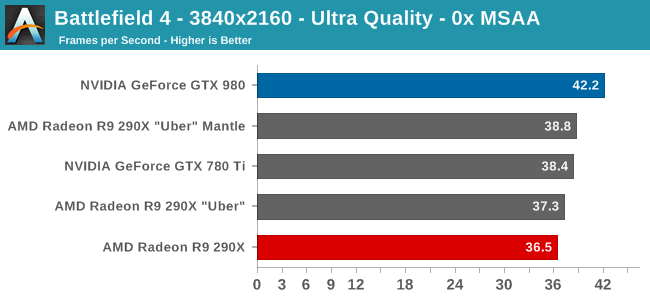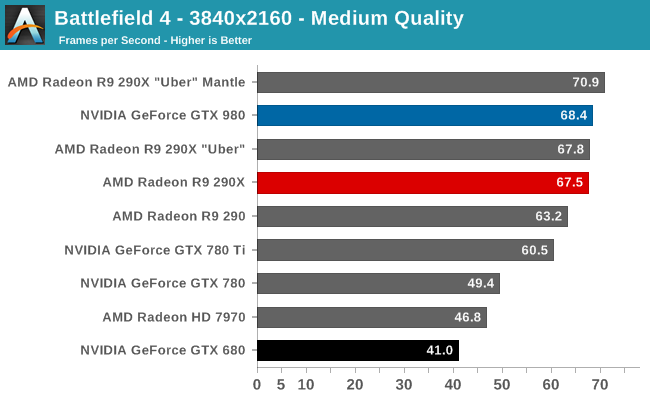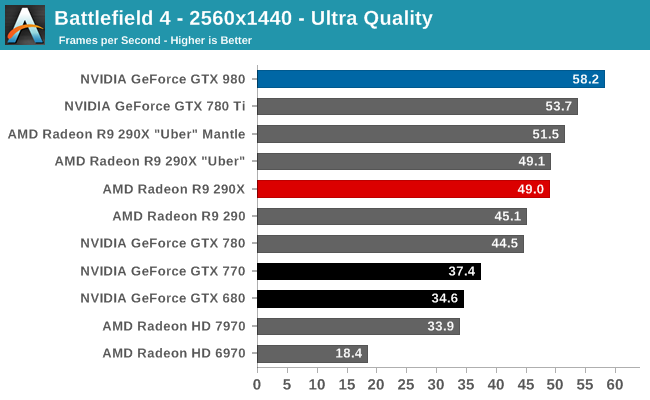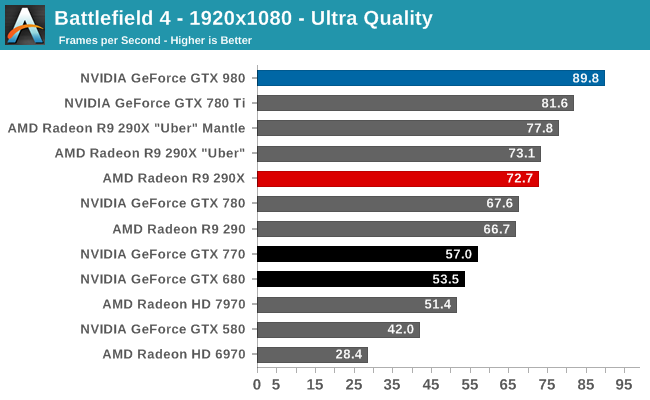The NVIDIA GeForce GTX 980 Review: Maxwell Mark 2
by Ryan Smith on September 18, 2014 10:30 PM ESTBattlefield 4
Our latest addition to our benchmark suite and our current major multiplayer action game of our benchmark suite is Battlefield 4, DICE’s 2013 multiplayer military shooter. After a rocky start, Battlefield 4 has finally reached a point where it’s stable enough for benchmark use, giving us the ability to profile one of the most popular and strenuous shooters out there. As these benchmarks are from single player mode, based on our experiences our rule of thumb here is that multiplayer framerates will dip to half our single player framerates, which means a card needs to be able to average at least 60fps if it’s to be able to hold up in multiplayer.




Battlefield 4 is one of our tougher games, especially with the bar set at 60fps to give us enough headroom for multiplayer performance. To that end the GTX 980 turns in another solid performance, though the dream of averaging 60fps at 1440p Ultra is going to have to wait just a bit longer to be answered.
Overall on a competitive basis the GTX 980 looks very strong. Against the GTX 780 Ti it further improves on performance by 8-13%, 30%+ against GTX 780, and 66% against GTX 680. Similarly it fares well against AMD’s cards – even with their Mantle performance advantage – with the exception of one case: 4K at Medium quality. With maximum quality settings, at all resolutions the GTX 980 can outperform AMD’s best by around 15%. But in the case of 4K Medium, with the lesser shader overhead in particular the R9 290XU gets to pull ahead thanks to Mantle. At this point NVIDIA is losing by just 4%, but it goes to show how close the race between these two cards is going to be at times and why AMD is never too far behind NVIDIA in several of these games.
In any case for Ultra quality you’re looking at the GTX 980 being enough for 1080p and even 1440p if you flex the 60fps rule a bit. 4K at these settings though is going to be the domain of multi-GPU setups.


Meanwhile delta percentage performance is extremely strong here. Everyone, incuding the GTX 980, is well below 3%.











274 Comments
View All Comments
squngy - Wednesday, November 19, 2014 - link
It is explained in the article.Because GTX980 makes so many more frames the CPU is worked a lot harder. The W in those charts are for the whole system so when the CPU uses more power it makes it harder to directly compare GPUs
galta - Friday, September 19, 2014 - link
The simple fact is that a GPU more powerful than a GTX 980 does not make sense right now, no matter how much we would love to see it.See, most folks are still gaming @ 1080, some of us are moving up to 1440. Under this scenarios, a GTX 980 is more than enough, even if quality settings are maxed out. Early reviews show that it can even handle 4K with moderate settings, and we should expect further performance gains as drivers improve.
Maybe in a year or two, when 4K monitors become more relevant, a more powerful GPU would make sense. Now they simply don't.
For the moment, nVidia's movement is smart and commendable: power efficiency!
I mean, such a powerful card at only 165W! If you are crazy/wealthy enough to have two of them in SLI, you can cut your power demand by 170W, with following gains in temps and/or noise, and and less expensive PSU, if you're building from scratch.
In the end, are these new cards great? Of course they are!
Does it make sense to up-grade right now? Only if you running a 5xx or 6xx series card, or if your demands have increased dramatically (multi-monitor set-up, higher res. etc.).
Margalus - Friday, September 19, 2014 - link
A more powerful gpu does make sense. Some people like to play their games with triple monitors, or more. A single gpu that could play at 7680x1440 with all settings maxed out would be nice.galta - Saturday, September 20, 2014 - link
How many of us demand such power? The ones who really do can go SLI and OC the cards.nVidia would be spending billions for a card that would sell thousands. As I said: we would love the card, but still no sense
Again, I would love to see it, but in the forseeable future, I won't need it. Happier with noise, power and heat efficiency.
Da W - Monday, September 22, 2014 - link
Here's one that demands such power. I play 3600*1920 using 3 screens, almost 4k, 1/3 the budget, and still useful for, you know, working.Don't want sli/crossfire. Don't want a space heater either.
bebimbap - Saturday, September 20, 2014 - link
gaming at 1080@144 or 1080 with min fps of 120 for ulmb is no joke when it comes to gpu requirement. Most modern games max at 80-90fps on a OC'd gtx670 you need at least an OC'd gtx770-780. I'd recommend 780ti. and though a 24" 1080 might seem "small" you only have so much focus. You can't focus on periphery vision you'd have to move your eyes to focus on another piece of the screen. the 24"-27" size seems perfect so you don't have to move your eyes/head much or at all.the next step is 1440@144 or min fps of 120 which requires more gpu than @ 4k60. as 1440 is about 2x 1080 you'd need a gpu 2x as powerful. so you can see why nvidia must put out a powerful card at a moderate price point. They need it for their 144hz gsync tech and 3dvision
imo the ppi race isn't as beneficial as higher refresh rate. For TVs manufacturers are playing this game of misinformation so consumers get the short end of the stick, but having a monitor running at 144hz is a world of difference compared to 60hz for me. you can tell just from the mouse cursor moving across the screen. As I age I realize every day that my eyes will never be as good as yesterday, and knowing that I'd take a 27" 1440p @ 144hz any day over a 28" 5k @ 60hz.
Laststop311 - Sunday, September 21, 2014 - link
Well it all depends on viewing distance. I use a 30" 2560x1600 dell u3014 to game on currently since it's larger i can sit further away and still have just as good of an experience as a 24 or 27 thats closer. So you can't just say larger monitors mean you can;t focus on it all cause you can just at a further distance.theuglyman0war - Monday, September 22, 2014 - link
The power of the newest technology is and has always been an illusion because the creation of games will always be an exercise in "compromise". Even a game like WOW that isn't crippled by console consideration is created by the lowest common denominator demographic in the PC hardware population. In other words... ( if u buy it they will make it vs. if they make it I will upgrade ). Besides the unlimited reach of an openworld's "possible" textures and vtx counts."Some" artists are of the opinion that more hardware power would result in a less aggressive graphic budget! ( when the time spent wrangling a synced normal mapped representation of a high resolution sculpt or tracking seam problems in lightmapped approximations of complex illumination with long bake times can take longer than simply using that original complexity ). The compromise can take more time then if we had hardware that could keep up with an artists imagination.
In which case I gotta wonder about the imagination of the end user that really believes his hardware is the end to any graphics progress?
ppi - Friday, September 19, 2014 - link
On desktop, all AMD needs to do is to lower price and perhaps release OC'd 290X to match 980 performance. It will reduce their margins, but they won't be irrelevant on the market, like in CPUs vs Intel (where AMD's most powerful beasts barely touch Intel's low-end, apart from some specific multi-threaded cases)Why so simple? On desktop:
- Performance is still #1 factor - if you offer more per your $, you win
- Noise can be easily resolved via open air coolers
- Power consumption is not such a big deal
So ... if AMD card at a given price is as fast as Maxwell, then they are clearly worse choice. But if they are faster?
In mobile, however, they are screwed big way, unless they have something REAL good in their sleeve (looking at Tonga, I do not think they do, as I am convinced AMD intends to pull off another HD5870 (i.e. be on the new process node first), but it apparently did not work this time around.)
Friendly0Fire - Friday, September 19, 2014 - link
The 290X already is effectively an overclocked 290 though. I'm not sure they'd be able to crank up power consumption reliably without running into heat dissipation or power draw limits.Also, they'd have to invest in making a good reference cooler.